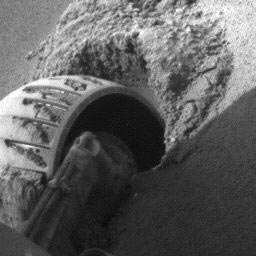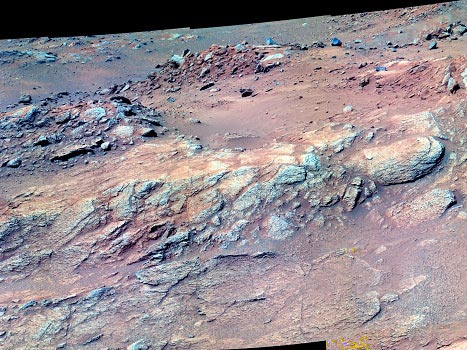

Space Camp Kalpana Chawla Image : Opportunity's left front wheel. Image credit: NASA/JPL. NASA's Rovers Continue Martian Missions 05.24.05 -- NASA's Mars rover Opportunity is trying to escape from a sand trap, while its twin, Spirit, has been busy finding new clues to a wet and violent early Martian history.
Methuselah in False Color 5/24/05
Hubble Space Telescope Skylab was actually the refitted S-IVB third stage of a Saturn V booster, a leftover from the Apollo program originally intended for one of the canceled moon landing missions (Apollos 18-20). A product of the Apollo Applications program (a program tasked with finding long-term uses for Apollo program hardware), Skylab was originally planned as a minimially-altered S-IVB to be launched on a Saturn IB rocket. The small size of the IB would have required Skylab to double as a rocket stage during launch, only being retrofitted as a space station once on-orbit. With the cancellation of Apollo missions 18-20 a Saturn V was made available and thus the "Wet Workshop" concept, as it was called, was put aside and Skylab was launched dry and fully outfitted. Skylab's grid flooring system is a highly visable legacy of the wet workshop concept. Following the last mission the Station was positioned in a parking orbit expected to last at least 8 years. Increased solar activity heating the outer layers of the earth's atmosphere and thereby increasing drag on the Station led to an early reentry on July 11, 1979. Skylab disintegrated over Western Australia and the Indian Ocean, casting large pieces of debris in populated areas (without injury). The reentry prevented any further use by the then unfinished Space Shuttle as was envisioned by some at NASA. Two flight-quality Skylabs were built, the second, a backup, is on display at the National Air and Space Museum in Washington, DC.
ALT The Space Shuttle consists of four main components; the reuseable orbiter itself, a large expendable external fuel tank, and a pair of reusable solid-fuel booster rockets. The fuel tank and booster rockets are jettisoned during ascent. The longest the shuttle has stayed in orbit in a single mission is 17.5 days, on mission STS-80 in November 1996. The Shuttle has a large payload bay taking up much of its length. The payload bay doors have heat radiators mounted on their inner surfaces, and so are kept open while the Shuttle is in orbit for thermal control. Thermal control is also maintained by adjusting the orientation of the Shuttle relative to Earth and Sun. Inside the payload bay is the Remote Manipulator System, also known as the Canadarm, a robot arm used to retrieve and deploy payloads. Until the loss of Columbia, the Canadarm has only been included on missions where it will be used. Since the arm is a crucial part of the Thermal Protection Inspection procedures now required for shuttle flights, it will likely be included on all future flights.Shuttles
Space Camp Space Camp is a 1986 movie which was based on a book written by Patrick Bailey and Larry B Williams and a screenplay by WW Wicket and Casey T Mitchell. In the movie, four teenagers and a twelve year old boy go to a NASA space camp, to spend three weeks of their summer training as astronauts and learning about the space program in general. There, they will meet a female instructor who is frustrated at the fact she still hasn't gotten a chance to be up there, despite this being her life's dream. But things start to unravel when the 12 year old boy, Max, saves the life of a robot named Jinx, and, to return the favor, Jinx decides to send Max
Discover NASA
(July 1, 1961 - February 1, 2003) was an astronaut and space shuttle mission specialist of STS-107 (Columbia) who was killed when the craft disintegrated after reentry into the Earth's atmosphere. Kalpana Chawla Table of contents showTocToggle("show","hide") 1 Early Life 2 Education 3 NASA Career 4 Personal Characteristics 5 Memoria 6 See also 7 External Links Early Life Chawla was born in Karnal, Haryana, India. Her interest in flight was inspired by J. R. D. Tata, India's first pilot. Education Chawla studied aeronautical engineering at the Punjab Engineering College in Punjab, India in 1982 where she earned her Bachelor of Science degree. Thereafter she moved to the United States to obtain a Master of Science degree in aerospace engineering from University of Texas (1984). Dr. Chawla earned a doctorate in aerospace


Hubble Space Telescope The Hubble Space Telescope (HST, or Hubble) is a telescope located at the outer edges of Earth's atmosphere, about 600 kilometerss above the ground, orbiting the Earth every 100 minutes. It was placed into orbit, in April 1990, as a joint project of NASA and the ESA. The telescope can achieve optical resolutions greater than 0.1 arcseconds. The HST is named after Edwin Hubble. It is scheduled for replacement, by the James Webb Space Telescope (JWST), in 2009. Every day, the Hubble Space Telescope archives 3 to 5 gigabytes of data and delivers between 10 and 15 gigabytes to astronomers. Working outside the atmosphere has advantages because the atmosphere obscures images and filters out electromagnetic radiation at certain wavelengths, mainly in the infrared. Hubble
America's first space station, the 75 ton Skylab was launched May 14, 1973 by a two-stage version of the Saturn V booster (the SL-1 mission). Severe damage was sustained during launch, including the loss of the station's micrometeoroid shield/sun shade and one of its main solar panels. Debris from the lost micrometeroid shield further complicated matters by pinning the remaining solar panel to the side of the station, preventing its deployment and thus leaving the station with a huge power deficit. The station underwent a extensive repair by the first crew launched on May 25, 1973 (the SL-2 mission) atop a Saturn 1B. Two additional missions followed on July 28, 1973 (SL-3) and November 16, 1973 (SL-4) with stay times of 28, 59, and 84 days, respectively. The last Skylab crew returned to Earth on February 8, 1974.
Tim Finn and Liam O'Maonlai. ALT is also an abbreviation for Assistant Language Teacher, the job title of people on the JET Programme. ALT was also an acronym by the NASA for the Approach and Landing Tests of the Space Shuttle in 1976. ALT can mean alternative lengthening of telomeres, a mechanism (other than telomerase) that cells use to maintain telomere length.
Shuttle description